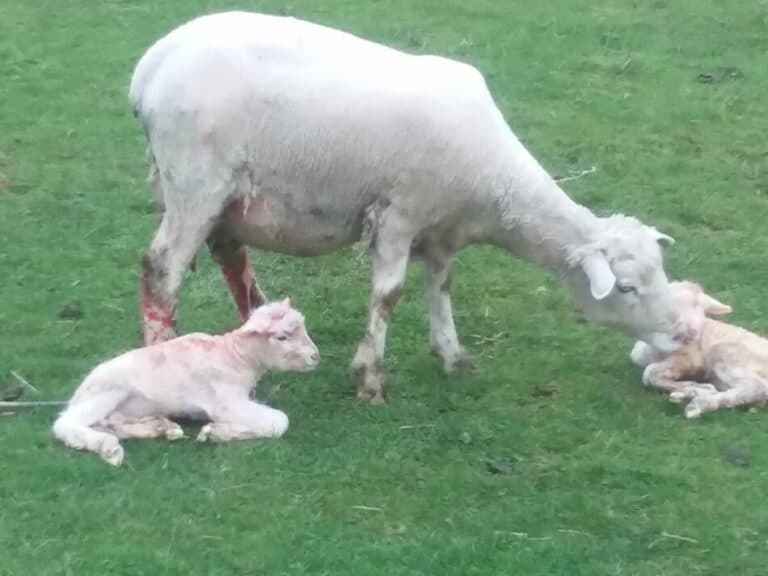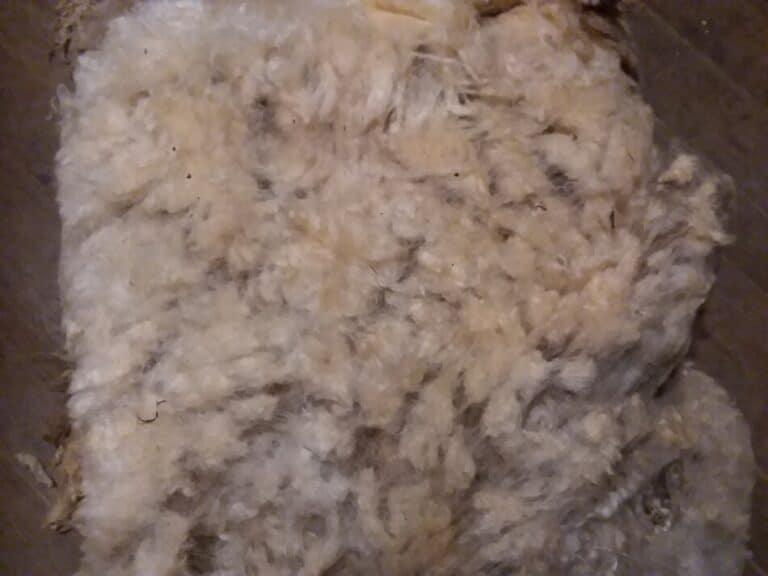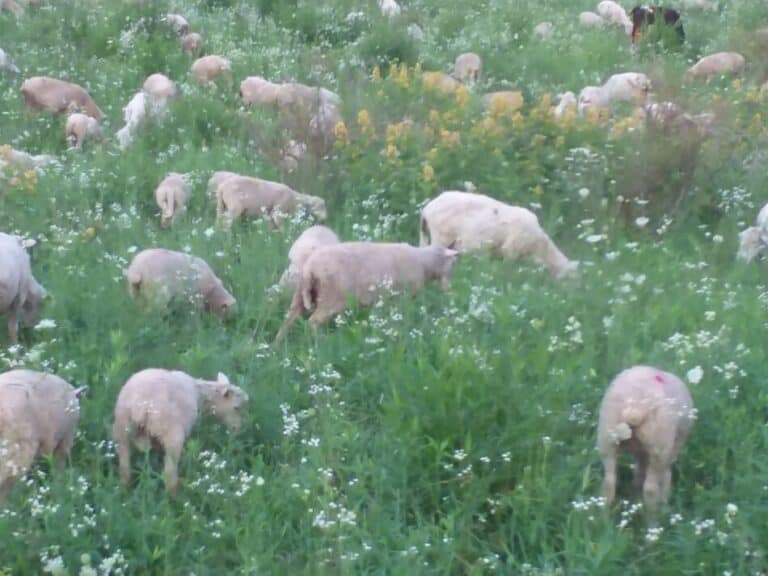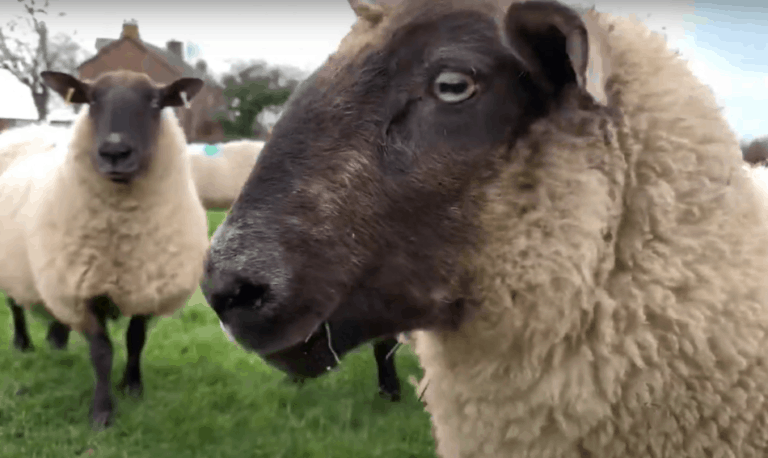What To Feed Your Sheep & What Not To Feed Them!
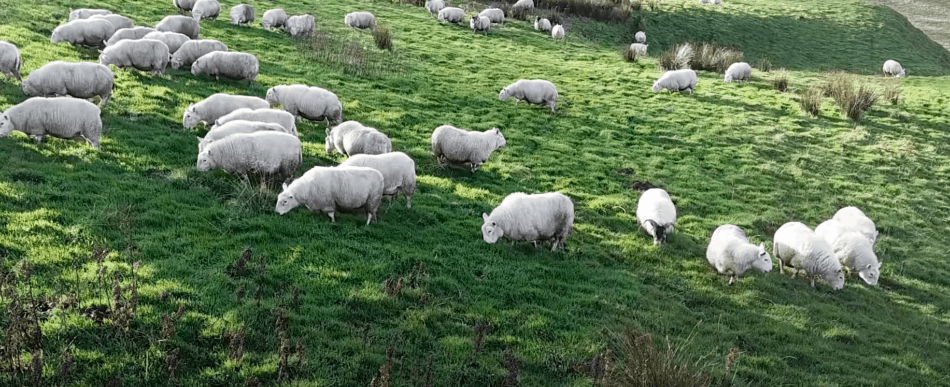
Sheep are a wonderful and versatile animal to have. It’s no wonder they are growing in popularity, for both large and small acreages! Once you get your flock, what should you feed them and what feeds should you avoid?
Sheep grow well on grass, hay and haylage, with stored forages (hay) eaten in the non growing season. All new feedstuffs should be gradually introduced to the flock. Sheep should not be fed anything moldy or processed (manufactured for human consumption) foods.
One of the best things about sheep is that they can eat nearly anywhere. We frequently have our flock’s rotation go right next to buildings or through the yard. Why not? Whatever they eat doesn’t need to be mowed!
How Many Bales Of Hay Do Sheep Need? will help you figure out the hay you’ll need to source for your flock.
Sheep normally eat grass and hay
Sheep normally eat grass through out the growing season of the year. Sheep can happily live on grass alone, with salt and water, of course!
Since sheep are ruminants, like cattle, sheep are built to eat grass or other forages and grow well on them, without needing feed in the form of grain.
How can sheep live on grass alone? Because ruminants, animals that chew their cud and have a complex stomach, can get the nutrients in plants that simple stomached animals, like us, can not breakdown.
To us, eating grass is a waste of time, for a sheep, eating grass is a good lunch!
The first picture is Cheviot mules grazing in Scotland, from The Sheep Game YouTube Channel. Check it out for insight on Sheep and shepherding in Scotland. The videos are fun and it’s a very different style of sheep farming than here.
In winter or the non growing season sheep eat stored forages
In the non growing season, which is winter here in Ohio, but in other places can be a dry season that has little to no active forage growth, sheep need to be fed stored forages, like hay, haylage or stockpiled grass.
Hay: is dried grass that is stored for feeding later in the year.
The grass is cut, left to dry in the sun, raked and baled up, then stored out of the rain until the hay is needed at a later date. Hay is always dry and can come from many different plants and have varying levels of nutritional quality.
Best Hay For Sheep will go over the different cuttings of hay and when you should use them.

Haylage: is wilted grass or other forages that is cut like hay but harvested at a higher moisture level then sealed off from air, so the forage is preserved by fermentation. When fed haylage is damp and has a nice pickled smell.
Haylage can be kept in large round or square bales that are wrapped in plastic, to keep out the air, or it can be harvested by a chopper and put in a huge pile, called a clamp or bunk silo, and covered with plastic to ferment.
Haylage is very popular in areas that have a hard time getting forages dry enough to make as hay.
Stockpiled forage: is letting a field grow during the growing season and harvesting it with the sheep during the non growing season.
This is popular with folks that have more land than they need for summer grazing, so they can let the field grow without needing to use it for the flock, and are willing to have the sheep outside for the winter to eat the stockpile.
Not all forages will stockpile well, for instance, grasses, especially fescue, will stockpile while clover will not. Grass can handle some frost, clover will melt after the first frost, so it won’t be there for the flock to eat later.
Stockpiled forage is how Greg Judy of Green Pastures Farm keeps his cattle and sheep outside 365 days of year and rarely feeds any hay or other stored feeds dispite having a substantial winter in his area.
If you would prefer to see his operation, he also has a YouTube channel Greg Judy, Regenerative Rancher.
Rich feeds, even hay, must be fed in limited quantities to sheep
Of all three forage sources listed above, hay, haylage and stockpile, only stockpile can be fed like pasture, meaning you let the flock eat what they want for the day. Hay and haylage intake must be more closely monitored.
Hay and haylage vary in quality and nutrition
Hay and haylage vary considerably in quality and nutritional value, depending upon which plants were in the field and when in the growth cycle of the plant the hay or haylage was made.
Hay and haylage made from grass that is past it’s prime, overly mature with lots of seed heads will be much lower in nutritional value than hay or haylage made from plants that are cut just before the plant flowers.
On the other hand, hay or haylage made from a 2nd or 3rd cutting will be wonderful feed that your sheep will eat like candy, which is actually the potential problem. They will get sick if you let them eat too much, just like kids and candy.
The most likely hay or haylage to cause you problems, because it’s too good!, is 100% or a high percent alfalfa, especially the later cuttings, like 2nd and 3rd.
If you are not familiar with hay lingo, read Difference Between First And Second Cutting Hay.
This is wonderful hay or haylage, don’t get me wrong! Just realize you will have to use this high octane hay like a supplement, rather than the main feed.
Very high nutrition hay must be introduced gradually to your sheep
We feed really nice hay like a snack, for instance to ewes with lambs in the barn. They would get their normal hay for the day then at night a small amount of the really nice hay to top off their nutrition.
If you give them all they want of the really nice hay, they will make themselves sick. Sheep are wimpy when then are sick and do not recover well, so it’s best to prevent problems rather than treat them.
The exception here for feeding unlimited rich hay is for young lambs with access to a creep feeder.
The nice hay must be in place when the lambs are a week old or less, this way they kind of stumble into it. If the lambs are older, you have to slowly introduce the nice hay or they will “pig out” on it and be sick.
Look for “opportunity feeds” in your area for sheep
You may find there are other feeds for your sheep that are available to you and not being well used in your community.
Your sheep will enjoy an occasional snack of produce or fruit
I’m referring to things like blemished pumpkins from a produce farm or weird shaped carrots that you grew in your garden.
Sheep like root vegetables and squash/pumpkins and will readily eat them. Other fruits can be given on a limited basis, see how the sheep like them and only give a few at a time.
Sheep will overeat, you have to limit the new food because they won’t. Which you’ll pay for tomorrow or the next day when you are dealing with sick sheep. It’s easier to just give a small amount to begin with!
A larger scale opportunity feed for your flock is unused grass in your area
Another option is to use the unused grass in your community to feed your flock. If you look around there are tons of opportunities for grazing animals to do work that the mowers are currently doing.
Under power lines, around solar arrays, that big stretch of grass that you drive by at the edge of town, these and many more are all sheep grazing opportunities that will help both the person owning the land and the flock owner.
Around here, grazing rather than mowing is still not a popular idea, sadly. But in other parts of the country, especially the drier areas, grazing down grass to reduce the wildfire potential is standard practice.
Things you should not feed sheep
There are feeds and plants that you should not feed sheep including:
- poisonous plants
- moldy hay
- moldy grain
- pasture that has been sprayed with herbicides
- unlimited access to new feeds
- packaged foods
Forages are the main diet of sheep, not people foods
Sheep naturally grow well on forages. If you are feeding them something that would not be considered a forage (like packaged foods from the list above), you should reconsider your plan.
Any packaged “people foods” are not an appropriate sheep food.
Sheep should not be fed junk hay or grain
Sheep need high quality, nutritious forages to be healthy, using them as a garbage disposal for junk hay or grain is a bad idea.
Sheep will “pig out” on new feeds, introduce new feeds gradually
Here is one that may surprise you, unlimited access to new feeds will be a problem for your sheep. Some animals will self limit on feed (like pigs), but sheep will not. Sheep will eat and eat until they are very sick.
When they overeat, it is a lot of work to get them better and your work does not always save them, some will die even with treatment.
New feeds must be limited to small amounts and gradually built up to the level you want in the total ration.
Sheep with plenty of forages do not choose poisonous plants
If you give your sheep options of what to eat (mainly more pasture area), they will choose the nutritious plants and leave the poisonous ones alone.
If you are limiting the flock’s area or forcing them to eat down an area, then they will try out the poisonous plants eventually.
That still leaves the poisonous plants in the pasture for you to mow, but his will knock them back to give the grasses your sheep like a better chance to take over more ground.
Sheep should not eat in areas that are sprayed with herbicides
I know that sometimes certain plants can get out of control in a pastured area. You do not need to use chemicals to fix this, use the sheep.
The best way to handle this is to put the sheep in and let them eat what they can, then take out the flock and put in something else, like pigs or cattle, that will handle your problem “weed” or mow the area after the sheep leave.
You don’t need to spray your land, change how you manage the land and the forages that you are promoting will change accordingly.
If you are getting forages that you do not want in your pastures, change your management of the pasture to promote the forages you do want.
